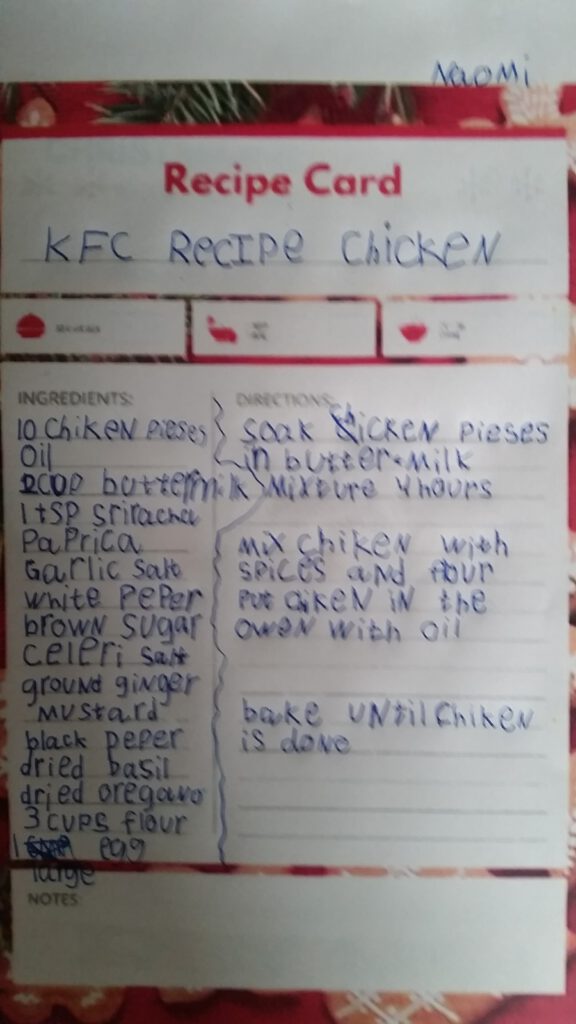
Interlanguage Analysis:
- Spelling: The student has some spelling errors, such as “ChiKeN” instead of “chicken,” “ReCIPe” instead of “recipe,” and “paprica” instead of “paprika.” This could be due to the influence of Danish spelling rules on English words.
- Vocabulary: The use of “owen” instead of “oven” and “peper” instead of “pepper” shows a mix of Danish and English vocabulary. Additionally, the use of “butter-milk mixture” instead of just “buttermilk” indicates that the learner perceives the word “buttermilk” (kærnemælk) as mixture of butter and milk 😀
- Grammar: The student uses simple sentence structures and imperative mood, which is appropriate for a recipe.
- Cultural Influence: The mention of KFC chicken and the use of ingredients like sriracha and mustard may reflect the student’s interest in Japanese culture and their fascination with newer customs like eating KFC on New Year’s Eve.
- Recipe Structure: The recipe lacks specific measurements for some ingredients, which may make it challenging for someone to replicate the dish accurately. Additionally, the directions could be more detailed, such as specifying the oven temperature and baking time.
Overall, the student’s background in Danish and interest in Japanese culture influence her English writing in this recipe, resulting in a mix of language elements from different sources. With more practice and exposure to English recipes, the student can improve her language skills and create more accurate and detailed recipes.
Interlanguage Analysis of a Learner Text (based on Bruntt & Bryanne):
Level 1: Content and Pragmatics:
Topic and task (content):
The topic is a recipe for making fried chicken. The learner does answer the question by providing a recipe for preparing KFC-style chicken.
Communicative situation (pragmatics):
The learner is writing a recipe for making fried chicken, which is typically instructional and informative. The genre elements include a list of ingredients and step-by-step instructions. The style is appropriate for the communicative situation of providing a recipe.
Level 2: Structure
Coherence and cohesion:
At text level:
The text has an introduction (listing the ingredients), a main body (the instructions for preparation), and a conclusion (serving the chicken). The learner sticks to the same general idea of providing a recipe for making fried chicken.
At paragraph level:
The division into paragraphs is clear, with separate sections for the ingredients and the instructions. The content of the individual paragraphs aligns logically with the whole text. The order of paragraphs is logical, and the paragraphs are connected using cohesive devices such as imperative verbs and time adverbs.
At sentence level:
There are some issues with cohesion, such as missing articles and prepositions. The learner uses imperative verbs and time adverbs to guide the reader through the recipe.
Level 3: Grammar, vocabulary, spelling, punctuation
Grammar:
The learner’s syntax and sentence construction are generally simple, which is appropriate for a recipe.
Vocabulary:
The learner uses a variety of vocabulary related to cooking and ingredients. However, there are some spelling errors and instances of incorrect vocabulary use which may interfere with meaning.
Punctuation:
The learner demonstrates basic punctuation skills, but there are some errors in capitalization and missing punctuation marks.
Interpretation of the analysis:
What is good about this text? What is the potential?
The learner provides a clear recipe with a logical structure, appropriate for the genre. The learner’s use of vocabulary related to cooking is commendable.
What types of problems (at levels 1, 2 and 3) disturb the meaning of the text?
The main problems include spelling errors, and translation issues that may affect the clarity and accuracy of the recipe.
What categories do the main problems belong to – interlingual or intralingual problems?
The problems mainly belong to intralingual issues, such as grammar errors, vocabulary misuse, and spelling mistakes.
What kind of feedback and help would you give to the learner?
The learner should focus on improving grammar accuracy. Additionally, working on vocabulary expansion and spelling accuracy would be beneficial.
What would you suggest the learner to work with in order to develop his/her language?
The learner should practice writing more recipes in English to improve language skills related to recipe writing. Additionally, reading English recipes and paying attention to sentence structure, vocabulary usage, and punctuation would be helpful for language development.
 Dansk
Dansk English (UK)
English (UK) Русский
Русский Español
Español